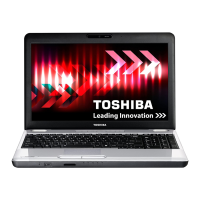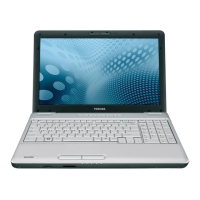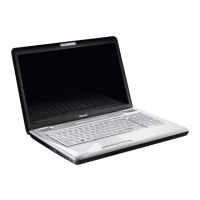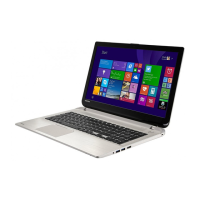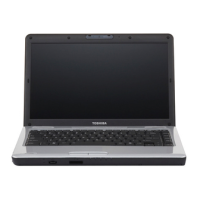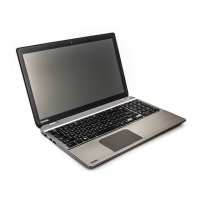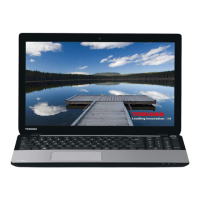
Do you have a question about the Toshiba Satellite L555D-S7005 and is the answer not in the manual?
| RAM | 4 GB |
|---|---|
| RAM Type | DDR2 |
| Storage | 320 GB |
| Hard Drive Speed | 5400 RPM |
| Resolution | 1366 x 768 |
| Optical Drive | DVD SuperMulti drive |
| Wireless | Wi-Fi 802.11b/g/n |
| LAN | 10/100 Ethernet |
| USB Ports | 3 x USB 2.0 |
| Bluetooth | No |
| Battery | 6-cell Lithium-ion |
| Display | 15.6 inch |
| Graphics | ATI Mobility Radeon HD 4100 |
| Operating System | Windows 7 Home Premium |
| Ports | VGA, RJ-45 |
Lists all hardware and pre-installed software included with the computer.
Details the computer's processor, chipset, memory, disks, and various hardware components.
Describes pre-installed utilities and applications for enhanced computer functionality.
Identifies and describes the computer's external components and their locations.
Explains the function of various ports and system status LED indicators.
Covers optical disc drive capabilities, region codes, and writable media types.
Details keyboard indicators and touchpad functionality and gestures.
Step-by-step guide for connecting the AC adaptor and powering on the computer.
Instructions on how to properly shut down, hibernate, sleep, or restart the computer.
Procedures for system recovery, creating discs, and restoring pre-installed software.
Explains how to use the touchpad, including gestures and control buttons.
Covers loading, removing discs, front panel controls, and writing CDs/DVDs.
Provides guidance on media care and using specific software like Disc Creator and DVD Player.
Details sound system adjustments, audio manager, web camera, and face recognition.
Explains modem setup, region selection, and connecting/disconnecting cables.
Covers LAN setup, wireless LAN, Bluetooth, and connection indicators.
Describes the keyboard layout, typewriter keys, and function keys (F1-F12).
Explains hot keys, FN key combinations, Windows special keys, and ASCII character generation.
Details power conditions, indicators, and battery status.
Provides guidance on battery pack care, charging procedures, and battery life.
Covers data retention when power is off and extending battery life.
Explains TOSHIBA Password Utility for user and supervisor passwords.
Describes power-up modes (Hibernation, Sleep, Boot) and Windows utilities.
Instructions on accessing and using the HW Setup program for system configuration.
Details settings for General, Password, Display, Keyboard, USB, and LAN configurations.
Lists and categorizes optional devices like cards, memory, power, and peripherals.
Covers bridge media slots, memory media types, and module installation/removal.
Details battery packs, AC adaptors, and battery chargers.
Explains the connection and usage of USB floppy drives, eSATA, external monitors, and HDMI.
Covers the security lock slot and its connection procedure.
Outlines the process for identifying and resolving computer problems.
Addresses problems related to system start-up, self-test, power, overheating, and battery issues.
Troubleshoots problems with CDs, DVDs, floppy diskettes, and memory cards.
Provides solutions for touchpad and mouse operational problems.
Solves issues with USB devices, eSATA, additional memory modules, and external monitors.
Addresses problems with sound systems, modems, LAN, Wireless LAN, and Bluetooth.
Guides users on seeking further assistance from TOSHIBA or resellers.
Details disclaimers regarding CPU, memory, battery life, HDD capacity, and graphics performance.
Lists operating and non-operating environmental conditions for the computer.
Specifies AC adaptor and computer power input requirements.
Explains the function and capabilities of the computer's display controller.
Details the technical specifications of the Wireless LAN card.
Covers radio frequency, range, and supported frequency sub-bands for wireless communication.
Lists the required specifications for AC power cords and connectors.
Enlists the certification agencies for power cords in various regions.
Explains the function and data collection of the PC Health Monitor software.
Provides instructions on how to start and enable the PC Health Monitor software.
Offers advice on preventing theft and procedures for reporting a stolen computer.
Details the process for registering theft information with TOSHIBA.
Lists common abbreviations used in the manual with their definitions.
Provides an alphabetical listing of keywords and their corresponding page numbers.

